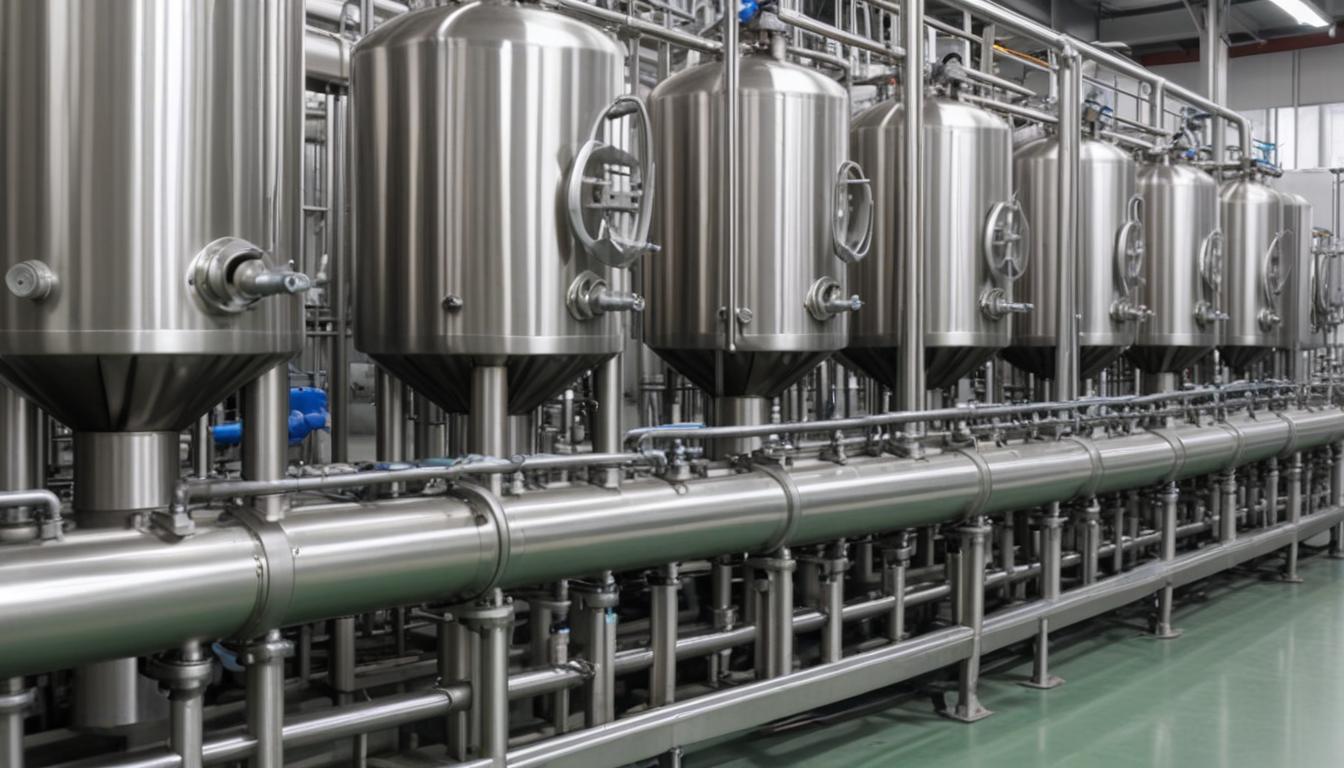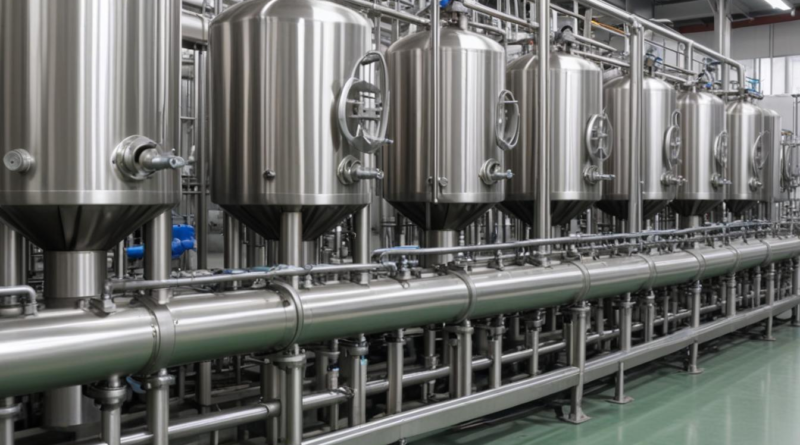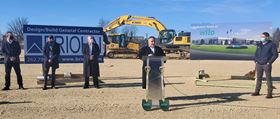pumps used in the beverage bottling industry
There are several pumps commonly utilized within the bottling industry, each tailored to specific applications to ensure efficient and hygienic handling of beverages. Understanding the distinct types is crucial for optimal performance and reliability in beverage processing and packaging.
1. Centrifugal Pumps
Centrifugal pumps are widely used due to their simplicity and ability to handle large volumes of liquid with relatively low viscosity. They operate by converting rotational kinetic energy to hydrodynamic energy, efficiently moving beverages through the bottling lines.
– Advantages:
– High flow rates
– Smooth and continuous flow
– Low maintenance requirements
– Applications:
– Water transfer
– Juice and soft drink dispensing
– Beer and wine processing
2. Positive Displacement Pumps
These pumps deliver precise volumes of liquid by trapping a fixed amount and forcing it through the system. They are ideal for applications requiring accurate dosing and handling of viscous or particulate-laden beverages.
– Types of Positive Displacement Pumps:
– Gear Pumps: Suitable for thick beverages like syrups.
– Diaphragm Pumps: Ideal for hygienic applications requiring gentle handling.
– Peristaltic Pumps: Perfect for sterile and contamination-free transfers.
– Advantages:
– Accurate volume control
– Capability to handle high-viscosity liquids
– Effective for dosing and blending processes
3. Peristaltic Pumps
Peristaltic pumps are a subset of positive displacement pumps that move liquid through a flexible tube by mechanically squeezing it. This design ensures that the beverage only contacts the tubing, maintaining hygiene and preventing contamination.
– Advantages:
– Sterile pumping with no contamination risk
– Easy maintenance and tubing replacement
– Suitable for pasteurized and carbonated beverages
– Applications:
– Filling and transfer of sensitive beverages
– Cleaning and sanitizing processes
4. Diaphragm Pumps
These pumps use a reciprocating diaphragm to create flow, offering precise control and suitable for delicate beverages that require gentle handling to maintain quality and carbonation levels.
– Advantages:
– High precision in flow control
– Excellent for sanitary applications
– Can handle abrasive or particulate-laden liquids
– Applications:
– Carbonated beverage transfer
– Wine and beer processing
– Juice bottling operations
5. Gear Pumps
Gear pumps operate by transferring liquid through the meshing of gears, making them effective for moving viscous beverages with consistency and reliability.
– Advantages:
– Consistent and reliable flow
– Capable of handling high-viscosity liquids
– Simple mechanical design
– Applications:
– Syrup and concentrate handling
– Thick beverage transfer
– Mixing and blending operations
Comparison of Pump Types:
| Pump Type | Advantages | Ideal Applications |
|---|---|---|
| Centrifugal | High flow rates, smooth flow, low maintenance | Water, juice, soft drinks, beer |
| Positive Displacement | Accurate dosing, handles viscous liquids | Syrups, precise blending |
| Peristaltic | Sterile, easy maintenance | Sensitive and carbonated beverages |
| Diaphragm | Precision, sanitary | Carbonated drinks, wine, beer |
| Gear | Consistent flow, simple design | Syrups, thick beverages |
Selecting the appropriate pump type is essential in meeting the specific requirements of different beverage bottling processes, ensuring product quality and operational efficiency.
selection criteria
When selecting the appropriate pump for a specific application within the bottling industry, several critical factors must be meticulously evaluated to ensure optimal performance, efficiency, and product integrity. The following criteria serve as essential guidelines in the decision-making process:
1. Flow Rate and Capacity
Determining the required flow rate is fundamental. This involves calculating the volume of beverage that needs to be transferred or processed within a given timeframe. An accurate assessment ensures that the selected pump can handle peak production demands without compromising on speed or consistency.
– Considerations:
– Maximum and average production rates
– Surge handling capabilities
– Scalability for future expansion
2. Viscosity of the Beverage
Beverages vary widely in viscosity, from thin liquids like water to thicker syrups and concentrates. The pump must be capable of handling the specific viscosity range of the product to maintain flow efficiency and prevent operational issues.
– High-Viscosity Beverages:
– Requires positive displacement pumps such as gear or diaphragm pumps
– Low-Viscosity Beverages:
– Suitable for centrifugal or peristaltic pumps
3. Hygiene and Sanitation Requirements
Maintaining stringent hygiene standards is paramount in the bottling industry to ensure product safety and compliance with regulatory standards. Pumps must be designed for easy cleaning and sanitization to prevent contamination and microbial growth.
– Features to Look For:
– Stainless steel construction
– Seamless surfaces to eliminate crevices
– CIP (Clean-In-Place) compatibility
4. Chemical Compatibility
The materials of construction must be compatible with the specific beverages being processed to prevent corrosion, leaching, and degradation. This ensures longevity of the pump and maintains the quality of the product.
– Common Materials:
– Stainless Steel: Resistant to acids, bases, and most sanitizing agents
– Food-Grade Plastics: Suitable for non-corrosive and less abrasive liquids
5. Energy Efficiency
Energy consumption directly impacts operational costs. Selecting an energy-efficient pump contributes to sustainability goals and reduces the overall expenditure.
– Efficiency Factors:
– Motor efficiency ratings
– Hydraulic design optimizing flow with minimal energy loss
– Variable speed drives for adjustable operation based on demand
6. Integration and Control
The pump must seamlessly integrate with existing bottling line systems, including control and automation platforms. Compatibility with sensors, controllers, and feedback mechanisms enhances operational precision and responsiveness.
– Integration Aspects:
– Compatibility with PLC (Programmable Logic Controllers)
– Availability of communication protocols (e.g., Modbus, Ethernet/IP)
– Ease of interfacing with existing software systems
7. Maintenance and Reliability
Operational uptime is critical to maintaining production schedules. Pumps should exhibit high reliability and be easy to maintain, minimizing downtime and repair costs.
– Maintenance Considerations:
– Availability of spare parts
– Accessibility of components for routine maintenance
– Predictive maintenance capabilities through monitoring technologies
8. Cost Constraints
Balancing upfront costs with long-term benefits is essential. While higher initial investments in quality pumps can lead to savings through durability and efficiency, budget limitations must also be respected.
– Cost Factors:
– Initial purchase price
– Installation and setup costs
– Long-term operational and maintenance expenses
9. Environmental Conditions
The operating environment, including temperature, humidity, and exposure to contaminants, can affect pump performance and lifespan. Selecting a pump suited to the specific environmental conditions ensures sustained functionality.
– Environmental Considerations:
– Temperature tolerance
– Resistance to dust and moisture
– Protection against explosive or corrosive atmospheres
10. Regulatory Compliance
Adhering to industry standards and regulations is mandatory. Pumps should comply with relevant certifications and guidelines to ensure legal and market acceptance.
– Key Standards:
– FDA (Food and Drug Administration) compliance
– EHEDG (European Hygienic Engineering & Design Group) standards
– NSF (National Sanitation Foundation) certifications
Selection Checklist:
| Criteria | Key Questions |
|---|---|
| Flow Rate | What is the required volume per minute/hour? |
| Viscosity | What is the viscosity range of the beverage? |
| Hygiene | What sanitation standards must be met? |
| Chemical Compatibility | Are materials compatible with the beverage? |
| Energy Efficiency | What are the energy consumption requirements? |
| Integration | How will the pump integrate with existing systems? |
| Maintenance | What are the maintenance needs and costs? |
| Cost | What is the budget for the pump? |
| Environmental Conditions | What are the operating environment specifications? |
| Regulatory Compliance | Which certifications are required? |
By meticulously evaluating each of these criteria, stakeholders within the bottling industry can make informed decisions that align with their operational goals, ensuring the selection of beverage pumps that deliver reliability, efficiency, and product excellence.
installation considerations
Proper installation of beverage pumps is critical to ensure their optimal performance and longevity within the bottling industry. Careful planning and adherence to best practices can mitigate potential issues and enhance the efficiency of pumping applications. The following considerations are essential during the installation process:
Site Preparation and Layout
Ensuring an appropriate site layout is fundamental. The installation area should accommodate the physical dimensions of the pump and allow sufficient space for operation and maintenance.
– Space Allocation:
– Allocate ample space around the pump for ease of access.
– Consider the vertical and horizontal clearances to facilitate installation and future servicing.
– Environmental Conditions:
– Assess the ambient temperature, humidity, and exposure to contaminants.
– Ensure the site is protected from extreme conditions that could affect pump performance.
Foundation and Mounting
A stable foundation is essential to minimize vibrations and maintain pump alignment.
– Foundation Requirements:
– Use a concrete base or mount the pump on vibration-dampening pads.
– Ensure the foundation is level and secure to prevent movement.
– Alignment:
– Precisely align the pump with the motor and connected piping to avoid undue stress on components.
– Utilize alignment tools to achieve accurate positioning.
Piping and Connections
Proper piping is crucial for efficient fluid transfer and to prevent leaks or pressure drops.
– Pipeline Design:
– Design piping layouts to minimize bends and restrictions, promoting smooth flow.
– Use appropriate materials compatible with the beverage being pumped.
– Connection Techniques:
– Employ secure sealing methods such as flanged or welded joints to ensure leak-proof connections.
– Incorporate flexible joints where necessary to accommodate thermal expansion and reduce stress.
Electrical Requirements
Adequate electrical setup ensures safe and reliable pump operation.
– Power Supply:
– Verify that the electrical supply meets the pump’s voltage and frequency specifications.
– Install appropriate circuit breakers and overload protection devices.
– Wiring Standards:
– Follow local electrical codes and standards for all wiring and connections.
– Use shielded cables in environments where electromagnetic interference may be a concern.
Control Systems Integration
Seamless integration with existing control systems enhances operational efficiency.
– Automation Compatibility:
– Ensure the pump can interface with PLCs (Programmable Logic Controllers) and other automation systems.
– Utilize communication protocols such as Modbus or Ethernet/IP for data exchange.
– Sensing and Feedback:
– Integrate sensors for flow rate, pressure, and temperature monitoring.
– Implement feedback mechanisms for real-time adjustments and process optimization.
Safety and Compliance
Adhering to safety standards is paramount to protect personnel and equipment.
– Regulatory Standards:
– Comply with industry standards such as FDA, EHEDG, and NSF certifications relevant to the bottling industry.
– Ensure all components meet hygienic design principles to prevent contamination.
– Safety Features:
– Install emergency shut-off mechanisms and safety interlocks.
– Provide adequate labeling and signage for hazardous areas or components.
Accessibility for Maintenance
Designing for easy access facilitates routine maintenance and reduces downtime.
– Service Access:
– Position the pump in a manner that allows straightforward access to critical components.
– Ensure there is adequate lighting and workspace for maintenance tasks.
– Modular Design:
– Utilize modular pump assemblies to simplify replacement or upgrades.
– Keep spare parts readily available to expedite repairs.
Installation Checklist:
| Installation Aspect | Key Considerations |
|---|---|
| Site Preparation | Space allocation, environmental conditions |
| Foundation and Mounting | Stable base, precise alignment |
| Piping and Connections | Efficient layout, secure sealing |
| Electrical Requirements | Proper power supply, compliant wiring |
| Control Systems Integration | Automation compatibility, sensor integration |
| Safety and Compliance | Regulatory adherence, safety features |
| Accessibility for Maintenance | Service access, modular design |
Installation Best Practices:
- Pre-Installation Planning: Conduct thorough site assessments and prepare detailed installation plans.
- Professional Installation: Engage qualified technicians to perform the installation, ensuring adherence to standards and specifications.
- Testing and Calibration: After installation, perform rigorous testing to verify pump functionality and calibrate settings as per operational requirements.
- Documentation: Maintain comprehensive records of the installation process, configurations, and any modifications made for future reference and compliance audits.
By meticulously addressing these installation considerations, stakeholders in the bottling industry can ensure that their beverage pumps operate efficiently, reliably, and in compliance with industry standards, thereby supporting seamless bottling operations and maintaining product quality.
maintenance and troubleshooting
 Regular maintenance and effective troubleshooting are essential to ensure the longevity and optimal performance of beverage pumps within the bottling industry. Implementing a structured maintenance program not only minimizes downtime but also enhances the reliability and efficiency of pumping applications. The following outlines key aspects of maintenance and troubleshooting:
Regular maintenance and effective troubleshooting are essential to ensure the longevity and optimal performance of beverage pumps within the bottling industry. Implementing a structured maintenance program not only minimizes downtime but also enhances the reliability and efficiency of pumping applications. The following outlines key aspects of maintenance and troubleshooting:
Preventive Maintenance
Establishing a preventive maintenance schedule helps in identifying and addressing potential issues before they escalate. This approach extends the lifespan of pumps and maintains consistent operation.
– Routine Inspections:
– Visual Checks: Examine pumps for signs of wear, leaks, and corrosion.
– Performance Monitoring: Regularly assess flow rates, pressure levels, and temperature to detect deviations from standard operating conditions.
– Scheduled Maintenance Tasks:
– Lubrication: Ensure all moving parts are adequately lubricated to reduce friction and prevent wear.
– Component Replacement: Replace wear-prone parts such as seals, gaskets, and bearings based on manufacturer recommendations.
– Cleaning: Maintain hygiene by cleaning pump interiors and external surfaces to prevent contamination and buildup.
Predictive Maintenance
Utilizing advanced monitoring technologies allows for the prediction of potential failures, enabling timely interventions.
– Vibration Analysis: Detect imbalances or misalignments by monitoring vibration patterns.
– Thermography: Identify overheating components through thermal imaging.
– Flow and Pressure Sensors: Continuously monitor operational parameters to anticipate performance issues.
Corrective Maintenance
Addressing issues as they arise is crucial for maintaining uninterrupted production. A systematic approach to troubleshooting ensures rapid resolution of problems.
Common Issues and Solutions
| Issue | Possible Causes | Solutions |
|---|---|---|
| Reduced Flow Rate |
|
|
| Excessive Noise |
|
|
| Overheating |
|
|
| Leakage |
|
|
Best Practices for Maintenance and Troubleshooting
Adhering to best practices enhances the effectiveness of maintenance activities and ensures swift troubleshooting.
– Documentation and Record-Keeping:
– Maintain detailed records of all maintenance activities, including inspections, repairs, and component replacements.
– Track performance data to identify trends and recurring issues.
– Training and Expertise:
– Ensure maintenance personnel are adequately trained in pump operation and troubleshooting techniques.
– Stay updated with manufacturer guidelines and industry standards.
– Spare Parts Management:
– Keep a stock of critical spare parts to facilitate quick replacements and minimize downtime.
– Use OEM (Original Equipment Manufacturer) parts to ensure compatibility and reliability.
– Standard Operating Procedures (SOPs):
– Develop and implement SOPs for routine maintenance tasks and emergency troubleshooting.
– Ensure all team members are familiar with these procedures to promote consistency and efficiency.
Maintenance Checklist
- Inspect for external damage and wear.
- Check and clean filters and strainers.
- Verify alignment of pump and motor.
- Monitor and maintain proper lubrication levels.
- Test electrical connections and controls.
- Assess seals and gaskets for integrity.
- Review and calibrate sensors and instrumentation.
Troubleshooting Steps
- Identify the Problem: Gather information on symptoms and operational anomalies.
- Isolate the Cause: Determine if the issue is mechanical, electrical, or related to the process.
- Implement Solutions: Apply the appropriate corrective measures based on the identified cause.
- Test and Verify: Confirm that the issue has been resolved and the pump is functioning correctly.
- Document the Process: Record the problem, actions taken, and the outcome for future reference.
By integrating comprehensive maintenance and effective troubleshooting strategies, organizations within the bottling industry can sustain high levels of operational efficiency and ensure the consistent quality of their beverage pumps.
future trends
Advancements in technology are poised to significantly transform the landscape of beverage pumps within the bottling industry. Emerging trends focus on enhancing efficiency, sustainability, and integration, ensuring that pumping applications remain at the forefront of innovation.
1. Smart Pumps and IoT Integration
The incorporation of Internet of Things (IoT) technology into pumps is revolutionizing the way they operate and are managed. Smart pumps equipped with sensors can monitor real-time performance metrics, enabling remote monitoring and control.
– Benefits:
– Real-Time Data Collection: Provides continuous monitoring of flow rates, pressure, and operational status.
– Remote Diagnostics: Facilitates troubleshooting and maintenance without the need for on-site presence.
– Enhanced Control: Allows for automated adjustments based on real-time data to optimize performance.
2. Energy Efficiency Improvements
With increasing emphasis on sustainability, the development of more energy-efficient pumps is a key trend. Innovations in motor technology and hydraulic design are reducing energy consumption while maintaining high performance.
– Strategies:
– Variable Speed Drives (VSDs): Adjust pump speed based on demand, minimizing energy usage during low-demand periods.
– Optimized Hydraulic Designs: Enhance flow efficiency and reduce energy loss through improved pump architecture.
– High-Efficiency Motors: Utilize advanced motor designs that offer better performance with lower energy input.
3. Sustainable Materials and Designs
Sustainability is driving the use of eco-friendly materials and designs in pump manufacturing. This not only reduces the environmental impact but also enhances the longevity and recyclability of pumps.
– Initiatives:
– Use of Recyclable Materials: Incorporating materials that can be easily recycled at the end of the pump’s lifecycle.
– Corrosion-Resistant Alloys: Extending pump lifespan by preventing degradation in harsh environments.
– Modular Designs: Facilitating easy replacement of components, reducing waste and resource consumption.
4. Advanced Automation and Control Systems
Automation is becoming increasingly sophisticated, with pumps integrating seamlessly into fully automated bottling lines. Enhanced control systems allow for precise regulation and synchronization with other machinery.
– Features:
– Programmable Logic Controllers (PLCs): Offer precise control over pump operations and integration with other automated systems.
– Advanced User Interfaces: Provide intuitive control and monitoring capabilities for operators.
– Feedback Mechanisms: Enable real-time adjustments to maintain optimal performance and product quality.
5. Enhanced Hygiene and Sanitation Features
Maintaining stringent hygiene standards is critical in the bottling industry. Future pump designs are focusing on improved sanitation features to prevent contamination and ensure product safety.
– Innovations:
– Seamless Construction: Minimizes crevices where contaminants can accumulate, facilitating easier cleaning.
– Sanitary Certifications: Adhering to international standards such as EHEDG and FDA to ensure compliance.
– Easy Disassembly: Simplifies cleaning and maintenance processes, reducing downtime and labor costs.
6. Modular and Scalable Pump Designs
Modularity allows for greater flexibility in pump applications, enabling easy upgrades and scalability to meet changing production demands.
– Advantages:
– Customizability: Modules can be added or removed based on specific application needs.
– Ease of Maintenance: Facilitates quicker repairs and component replacements without affecting the entire system.
– Scalability: Supports expansion of production capacity without significant reengineering.
7. Integration with Industry 4.0
The fourth industrial revolution, or Industry 4.0, emphasizes the integration of digital technologies into manufacturing processes. Pumps are becoming integral components of smart factories, leveraging data and connectivity for enhanced operations.
– Key Aspects:
– Data Analytics: Utilizing big data to optimize pump performance and predict maintenance needs.
– Cyber-Physical Systems: Creating interconnected systems where physical pumps interact with digital processes.
– Automated Decision-Making: Leveraging artificial intelligence to make real-time operational adjustments.
8. Predictive Maintenance Using AI and Machine Learning
Predictive maintenance leverages artificial intelligence (AI) and machine learning to foresee potential pump failures before they occur, reducing downtime and maintenance costs.
– Implementation:
– Data-Driven Insights: Analyzing historical and real-time data to identify patterns indicative of wear or impending failure.
– Automated Alerts: Notifying maintenance teams of potential issues, allowing for timely interventions.
– Continuous Learning: AI systems improve their predictive accuracy over time through machine learning algorithms.
9. Increased Customization for Specific Applications
As the bottling industry diversifies, there is a growing demand for customized pump solutions tailored to specific beverage types and processing requirements.
– Customization Options:
– Specialized Materials: Selecting materials that are best suited for particular beverages, such as acidic juices or carbonated drinks.
– Tailored Flow Rates and Pressures: Designing pumps to meet the unique flow and pressure requirements of different bottling processes.
– Integrated Features: Incorporating additional functionalities such as heating or cooling capabilities directly into the pump system.
10. Regulatory Changes and Compliance Needs
Evolving regulations are driving the need for pumps that can quickly adapt to new compliance standards, ensuring that beverage pumps remain legally viable and market-ready.
– Considerations:
– Adherence to Updated Standards: Ensuring pumps meet the latest industry and safety standards.
– Documentation and Traceability: Maintaining detailed records to demonstrate compliance during audits and inspections.
– Flexibility in Design: Allowing for easy modifications to meet changing regulatory requirements without extensive redesign.
Future Trends Summary:
| Trend | Impact |
|---|---|
| Smart Pumps and IoT Integration | Enhanced monitoring, remote control, and data-driven optimization. |
| Energy Efficiency Improvements | Reduced operational costs and environmental footprint. |
| Sustainable Materials and Designs | Longer pump lifespans and reduced waste. |
| Advanced Automation and Control Systems | Increased precision and seamless integration with automated lines. |
| Enhanced Hygiene and Sanitation Features | Improved product safety and compliance with hygiene standards. |
| Modular and Scalable Pump Designs | Greater flexibility and easier maintenance. |
| Integration with Industry 4.0 | Smarter operations through interconnected systems and data analytics. |
| Predictive Maintenance Using AI and Machine Learning | Reduced downtime and proactive maintenance scheduling. |
| Increased Customization for Specific Applications | Better performance tailored to unique bottling requirements. |
| Regulatory Changes and Compliance Needs | Ensured legal compliance and market readiness. |
Embracing these future trends will enable stakeholders in the bottling industry to enhance the efficiency, reliability, and sustainability of their beverage pumps. Staying ahead of technological advancements and regulatory changes will be crucial for maintaining competitive advantage and ensuring the delivery of high-quality products to the market.




